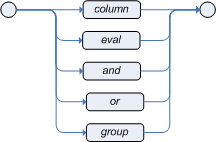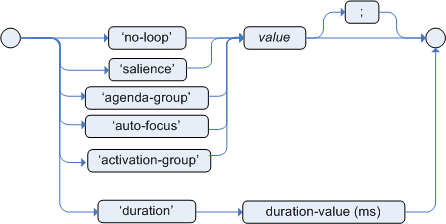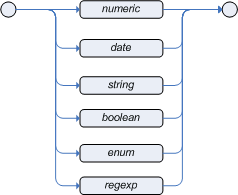(七): Drools規則語言詳解(下)
5. Rule

Rule 結構是最重要的結構。 Rule 使用了形如“ IF ” something “ THEN ” action (當然,我們的關鍵字是“ when ”和“ then ”)的形式。
一個規則在一個 package 中必須要有唯一的名字。如果一個名字中含有空格,那就需要將名字放在雙引號中(最好總是使用雙引號)。
Attribute 是可選的(最好是每行只有一個 Attribute )。
規則的 LHS 跟在“ when ”關鍵字的后面(最好是另起一行),同樣 RHS 要跟在“ then ”關鍵字后面(最好也另起一行)。規則以關鍵字“ end ”結束。規則不能嵌套。
5.1 Left Hand Side
Left Hand Side 其實就是規則的條件部分。 LHS 對應的 rail-road 圖如下,我們在后面會做進一步解釋:
![]()

5.2 Right Hand Side
在 RHS 中,你可以使用幾個方便的 method 來改變 WorkingMemory :
“ modify(obj) ”:告訴引擎一個對象已經發生變化,規則必須重新匹配( obj 對象必須是出現在 LHS 中的對象);
“ assert(new Something()) ”:將一個新的 Something 對象加入 WorkingMemory ;
“ assertLogical(new Something()) ”:與 assert 方法類似。但是,當沒有 fact 支持當前激發規則的真實性的時候,這個新對象會自動被 retract ,
“
retract(obj)
”:從
WorkingMemory
中移除一個對象。
這些方法都是宏指令,提供了到
KnowledgeHelper
實例的快捷方式(參考
KnowledgeHelper
接口)。
KnowledgeHelper
接口可以在
RHS
代碼塊中調用,通過變量“
drools
”。如果你在
assert
進引擎的
JavaBean
中加入“
Property Change Listener
”,在對象發生變化的時候,你就不用調用“
modify
”方法。
5.3 Rule Attributes

5.3.1 no-loop
默認值: false
類型: boolean
當在 rule 的 RHS 中修改了一個 fact ,這可能引起這個 rule 再次被 activate ,引起遞歸。將 no-loop 設為 true ,就可以防止這個 rule 的 Activation 的再次被創建。
5.3.2 salience默認值: 0
類型: int
每個 rule 都可以設置一個 salience 整數值,默認為 0 ,可以設為正整數或負整數。 Salience 是優先級的一種形式。當處于 Activation 隊列中時,擁有高 salience 值的 rule 將具有更高的優先級。
5.3.3 agenda-group
默認值:
MAIN
類型:
String
Agenda group
允許用戶對
Agenda
進行分組,以提供更多的執行控制。只有具有焦點的組中的
Activation
才會被激發(
fire
)。
默認值:
false
類型:
boolean
當一個規則被
activate
(即
Activation
被創建了),如果這個
rule
的
auto-focus
值為
true
并且這個
rule
的
agenda-group
沒有焦點,此時這個
Activation
會被給予焦點,允許這個
Activation
有
fire
的潛在可能。
默認值:
N/A
類型:
String
當處于同一個
activation-group
中的第一個
Activation fire
后,這個
activation-group
中其余剩下的
Activation
都不會被
fire
。
默認值:沒有默認值
類型: long
5.4 Column

Example?5.1.?Column
Cheese(?type? == ? " stilton " ,?price? < ? 10 ?)
一個 Column 由一個類的一個或多個域約束構成。第一個例子沒有約束,它將匹配 WorkingMemory 中所有的 Cheese 實例。第二個例子對于一個 Cheese 對象有兩個字面約束( Literal Constraints ),它們被用“,”號隔開,意味著“ and ”。

Example?5.2.?Bound Column
這個例子同前一個例子有點類似。但是在這個例子中,我們將一個變量綁定到匹配規則引擎的 Cheese 實例上。這意味著,你可以在另一個條件中使用 cheapStilton ,或者在 rule 的 RHS 中。
5.4.1 Field Constraints
Field Constraints
使規則引擎可以從
WorkingMemory
中挑選出合適的
Fact
對象。一個
Fact
的“
Field
”必須符合
JavaBean
規范,提供了訪問
field
的
getter
方法。你可以使用
field
的名字直接訪問
field
,或者使用完整的方法名(省略括號)。
例如,以我們的
Chess
類為例,下面是等價的:
Cheese(type = = …)
和
Cheese(getType = = …)
。這意味著,你可以使用不太嚴格遵守
JavaBean
規范對象。盡管如此,你要保證
accessor
方法是不帶參數的,以保證它不會改變對象的狀態。
注意:如果一個
field
使用原始類型(
primitive type
),
Drools
將會把它們自動裝箱成相應的對象(即使你使用
java 1.4
),但是在
java 1.4
下卻不能自動拆箱。總的來說,盡量在
rule
所使用的類中,使用非原始類型的域。如果是使用
java 5
,就可以比較隨意了,因為編譯器會幫你執行自動裝拆箱。

有效的操作符是同域類型相關的。例如,對于日期域,“ < ”意味著“之前”。“ matches ”只適用于 String 域,“ contains ”和“ excludes ”只適用于 Collection 類型域。
5.4.1.2 字面值約束( Literal Constraints )最簡單的域約束就是字面值約束,允許用戶將一個 field 約束于一個已知值。
注意:你可以檢查域是否為 null ,使用 = = 或 != 操作符和字面值‘ null ’關鍵字。如, Cheese(type != null) 。字面值約束,特別是“ = = ”操作符,提供了非常快的執行速度,因為可以使用散列法來提高性能。

Numeric
所有標準的
Java
數字基本類型都可以用。
有效操作符:
<!--[if !supportLists]--> ·???????? <!--[endif]--> ==
<!--[if !supportLists]--> ·???????? <!--[endif]--> !=
<!--[if !supportLists]--> ·???????? <!--[endif]--> >
<!--[if !supportLists]--> ·???????? <!--[endif]--> <
<!--[if !supportLists]--> ·???????? <!--[endif]--> >=
<!--[if !supportLists]--> ·???????? <!--[endif]--> <=
Example?5.3 .?Numeric Literal ConstraintDate
當前只對“
dd-mm-yyyy
”的日期格式提供默認支持。你可以通過指定
drools.dateformat
系統屬性,來改變默認的日期格式。如果需要更多的控制,要用謂詞約束(
Predicate Constraint
)。
有效操作符:
<!--[if !supportLists]--> ·???????? <!--[endif]--> ==
<!--[if !supportLists]--> ·???????? <!--[endif]--> !=
<!--[if !supportLists]--> ·???????? <!--[endif]--> >
<!--[if !supportLists]--> ·???????? <!--[endif]--> <
<!--[if !supportLists]--> ·???????? <!--[endif]--> >=
<!--[if !supportLists]--> ·???????? <!--[endif]--> <=
Example?5.4.?Date Literal ConstraintString
可以使用任何有效的
Java String
。
有效操作符:
<!--[if !supportLists]--> ·???????? <!--[endif]--> ==
<!--[if !supportLists]--> ·???????? <!--[endif]--> !=
Example?5.5.?String Literal ConstraintBoolean
只能用 “ true ”或“ false ”。 0 和 1 不能被識別,而且 Cheese(smelly) 也是不被允許的。
有效操作符:
<!--[if !supportLists]--> ·???????? <!--[endif]--> ==
<!--[if !supportLists]--> ·???????? <!--[endif]--> !=
Example?5.6?Boolean Literal ConstraintMatches Operator
Matches 操作符后面可以跟任何有效的 Java 正則表達式。
Example?5.7.?Regular Expression ConstraintContains Operator and Excludes Operator
“ contains ”和“ excludes ”可以用來檢查一個 Collection 域是否含有一個對象。
Example?5.8.?Literal Cosntraints with CollectionsCheeseCounter(?cheeses?excludes? " chedder " ?)
5.4.1.3 Bound Variable Constraint
可以將 Facts 和它們的 Fields 附給一個 Bound Variable ,然后在后續的 Field Constraints 中使用這些 Bound Variable 。一個 Bound Variable 被稱為聲明( Declaration )。 Declaration 并不能和“ matches ”操作符合用,但卻可以和“ contains ”操作符合用。
Example?5.9.?Bound Field using '==' operatorCheese(?type? == ?likes?)
在上面的例子中,“ likes ”就是我們的 Bound Variable ,即 Declaration 。它被綁定到了任何正在匹配的 Person 實例的 favouriteCheese 域上,并且用來在下一個 Column 中約束 Cheese 的 type 域。可以使用所有有效的 Java 變量名,包括字符“ $ ”。“ $ ”經常可以幫助你區分 Declaration 和 field 。下面的例子將一個 Declaration 綁定到匹配的實例上,并且使用了“ contains ”操作符。注意: Declaratino 的第一個字符用了“ $ ”:
Example?5.10?Bound Fact using 'contains' operatorCheesery(?cheeses?contains?$stilton?)
5.4.1.4 Predicate Constraints

Predicate 表達式可以使用任何有效的 Java 邏輯表達式。先前的 Bound Declaration 可以用在表達式中。
下面的例子將會找出所有男性比女性大
2
歲的
pairs of male/femal people
:
Person(?boyAge?:?age? -> ?(?girlAge.intValue()? + ? 2 ? == ?boyAge.intValue()?),?sex? = ? = ? " M " ?)
5.4.1.5 Return Value Constraints

一個 Retrurn Value 表達式可以使用任何有效的 Java 表達式,只要它返回一個對象,不能返回原始數據類型。如果返回值是原始數據類型,要先進行裝箱。先前的 Bound Declaration 也可以使用在表達式中。
下面的例子跟上一節的例子一樣,也將會找出所有男性比女性大 2 歲的 pairs of male/femal people 。注意:這里我們不用綁定 boyAge ,增加了可讀性:
Example?5.12.?Return Value ConstraintsPerson(?age? = ? = ?(? new ?Integer(girlAge.intValue()? + ? 2 )?),?sex? = ? = ? " M " ?)
5.5 Conditional Elements
Conditional Elements 用來連接一個或多個 Columns 。
5.5.1 “ and ”
Example?5.13. ?And
Cheese(?cheeseType?:?type?)?and?Person(?favouriteCheese? == ?cheeseType?)
5.5.2 “ or ”

Person(?sex? == ? " f " ,?age? > ? 60 ?)?or?Person(?sex? == ? " m " ,?age? > ? 65 ?)

Example?5.15.?or with binding
pensioner?:?(?Person(?sex? == ? " f " ,?age? > ? 60 ?)?or?Person(?sex? == ? " m " ,?age? > ? 65 ?)?)
“ or ” Conditional Element 的使用會導致多條 rule 的產生,稱為 sub rules 。上面的例子將在內部產生兩條規則。這兩條規則會在 WorkingMemory 中各自獨立的工作,也就是它們都能進行 match , activate 和 fire 。當對一個“ or ” Conditional Element 使用變量綁定時,要特別小心,錯誤的使用將產生完全不可預期的結果。
可以將“ OR ” Conditional Element 理解成產生兩條規則的快捷方式。因此可以很容易理解,當“ OR ” Conditional Element 兩邊都為真時,這樣的一條規則將可能產生多個 activation 。
5.5.3 “ eval ”
Eval is essentially a catch all which allows any semantic code (that returns a primitive boolean) to be executed. 在表達式中可以引用在 LHS 中出現的變量,和在 rule package 中的 Functions 。一個 Eval 應該是 LHS 中的最后一個 Conditional Element 。在一個 rule 中,你可以有多個 eval 。
Eval 不能被索引,因此不能像 Field Constraints 那樣被優化。盡管如此,當 Functions 的返回值一直在變化時,應該使用 Eval ,因為這在 Field Constraints 中時不允許的。如果規則中的其他條件都匹配,一個 eval 每次都要被檢查。(現在還不理解到底 eval 要怎么用?)
Example?5.16.?evalp2?:?Parameter()
eval(?p1.getList().containsKey(p2.getItem())?)
eval(?isValid(p1,?p2)?)? // this?is?how?you?call?a?function?in?the?LHS?-?a?function?called? // "isValid"
5.5.4 “ not ”

“ not ”是一階邏輯的存在量詞( first order logic’s Existential Quantifier ) , 用來檢查 WorkingMemory 中某對象的非存在性。現在,只有 Columns 可以放在 not 中,但是將來的版本會支持“ and ”和“ or ”。
Example?5.17.?No BusesExample?5.18.?No red Buses
not?(?Bus(color? == ? " red " ,?number? = ? = ? 42 )?)? // brackets?are?optional
5.5.5 “ exists ”

“ exists ” 是一階邏輯的存在量詞( first order logic’s Existential Quantifier ),用來檢查 WorkingMemory 中某對象的存在性。可以將“ exists ”理解為“至少有一個”( at least one… )。它的意義不同于只有 Column 本身,“ Column ”本身可以理解為“對于每一個 … ”( for each of … )。如果你對一個 Column 使用了“ exists ”,那么規則將只 activate 一次,而不管 WorkingMeomry 中有多少個數據匹配了那個條件。
現在,只有 Columns 可以放在“ exists ”中,但是將來的版本會支持“ and ”和“ or ”。
Example?5.19.?At least one BusExample?5.20.?At least one red Bus
5.5.6 “ group ”

Group 的作用相當于代數學中的“()”,顯式的指明操作的順序。
5.6
再談自動裝箱和原始類型
Java 5 支持在原始類型與其對應包裝類之間的裝拆箱。盡管如此,因為要讓 drools 能夠在 J2SE 1.4 下運行,我們不能依靠 J2SE 。因此, drools 自己實現了自動裝箱。被引用(即被 Bound Variable 綁定)的 Field 將被自動進行裝箱(如果它們本身就是 object ,就不會有任何變化)。盡管如此,必須要注意的是,他們并不會被自動拆箱。
還有一點要注意的,就是對于 ReturnValue Constraints ,返回值的代碼必須返回一個對象,而不能是一個原始類型。
6 . Query

一個 query 只包含了一個 rule 的 LHS 結構(你不用指定“ when ”或“ then ”)。這是查詢 WorkingMemory 中匹配條件的 Facts 的簡單的方法。
要得到結果,要使用 WorkingMemory.getQueryResults(“name”) 方法,其中“ name ”就是 query 的名字。 Query 的名字在 RuleBase 中是全局的,所以, do not add queries of the same name to different packages for the same RuleBase 。
下面的例子創建了一個簡單的 query 來查詢所有年齡大于 30 的人:
Example?6.1.?Query People over the age of 30?
????person?:?Person(?age?>?30?)
end
我們通過一個標準的循環來迭代一個返回的QueryResults對象。每一次的iterate將返回一個QueryResult對象。我們可以用QueryResult對象的get()方法來訪問每個Column,通過傳入Bound Declaration或index position。
Example?6.2.?Query People over the age of 30System.out.println(?"we?have?"?+?results.size()?+?"?people?over?the?age??of?30"?);
System.out.println(?"These?people?are?are?over?30:"?);
for?(?Iterator?it?=?results.iterator;?it.hasNext();?)?{
????QueryResult?result?=?(?QueryResult?)?it.next();
????Person?person?=?(?Person?)?result.get(?"person"?);
????System.out.println(?person.getName()?+?"\n"?);
}
posted on 2006-12-03 09:56 BPM 閱讀(1527) 評論(0) 編輯 收藏 所屬分類: 規則引擎


